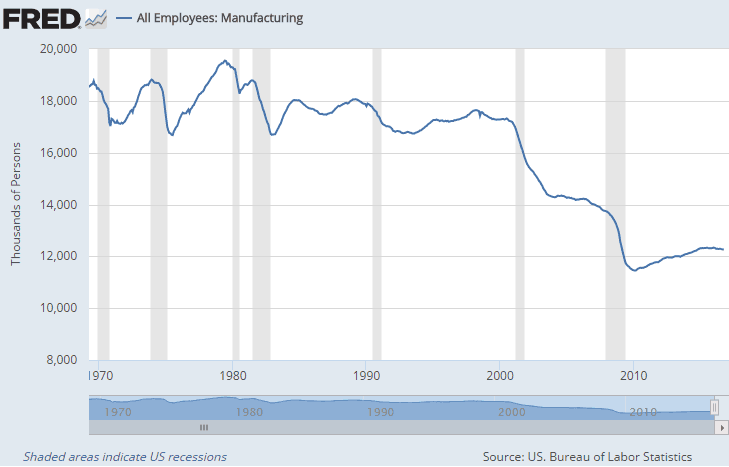There have clearly been tremendous, almost mind-boggling improvements in robotic technology in recent years.
Yet, the impact on employment in the US thus far - especially in the manufacturing sector - has been modest at best to date. Despite the rise of robotic capabilities over the period since the recession year of 2009, US manufacturing employment is up slowly but steadily, though tailing off just a bit in the past year, as can be seen in the chart below from the St. Louis branch of the Federal Reserve bank.
Supply Chain Digest Says... |
 |
China, where one province has an official "Robots for Humans" program, shows what the impact of jobs can be from heavy adoption of robots.
|
 |
What do you say? |
| Click here to send us your comments |
 |
| Click here to see reader feedback |
|
|
The gray vertical bars in the chart indicate recessions, and it is easy to see the sharp manufacturing job losses in those periods.
Writing in a recent issue of The Atlantic magazine, Derek Thompson has a theory about all this: the robots are likely to invade US factories in a big way and cost hundreds of thousands of workers their jobs when the next recession hits - and this lukewarm recovery is already pretty long in the tooth already.
Thompson notes that since the late 1960s, the US has shed a huge 10 million manufacturing jobs specifically during periods of recession, while some 4 million new workers were hired over that period in non-recessionary years. That obviously translates into a net loss in total of six million manufacturing jobs in the US since 1969.
It would seem US manufacturers are reluctant to shed workers and replace them with automation in periods of relatively good times. But when a slowdown arrives, they can shed workers in droves.
"The U.S. economy has been in a recession for less than 15% of the time between 1970 and 2015, but these periods accounted for 167% of the decline in manufacturing jobs," Thompson notes.
Interestingly, there are course are already some examples of substantial use of robotics or other automation in US factories.
For example, in 2013 SCDigest wrote about textile maker Parkdale Mills, which was bringing much production back to the US. That was the good news. The less good news: Parkdale's plant in South Carolina produces 2.5 million pounds of yarn a week with about 140 workers. In 1980, that production level would have required more than 2,000 people.
US Manufacturing Jobs have Really Contracted in Periods of Recession

Meanwhile, sport shoe makers Adidas, Nike and Under Armour are all in various stages of bringing production back to US soil. (See Under Armour Making Bold Move for Made in USA, Thinks it Can Help Reshape American Economy.)
(Article Continued Below)
|
CATEGORY SPONSOR: SOFTEON |
|
|
| |
|
|
But even if successful, these moves are likely to result in factory jobs in the hundreds, not the thousands as if often still the case overseas, as all these companies have heavy use of robotics to replace human workers as key to their reshoring success.
It is interesting to note that both Parkdale and the sports shoe manufacturers were dealing in product sectors where US manufacturing had declined precipitously over several decades. Robotics and other automation may be the only way production can be successfully returned to US soil in those product areas.
China, where one province has an official "Robots for Humans" program, shows what the impact of jobs can be from heavy adoption of robots.
Take the case of Rongxin Packaging Corporation, which produces over 600 million cans every year, or 1.8 million cans per day. A general manager at the company says the manufacturing process doesn't use any direct production workers any more.
"In 2013, we bought a new production line for over 34 million US dollars. We used to have 60 workers in one shift but now we only need 48. And they're only responsible for quality control and machine maintenance," the general manager said - the new machine does the actual production all by itself, adding employment is likely to go still lower.
A few years ago, SCDigest reported how the Changying Precision Technology Company factory in Dongguan has automated production lines that use robotic arms to produce parts for cell phones. The factory also has automated machining equipment, autonomous transport trucks, and other automated equipment in the warehouse.
Previously, there were 650 employees at the factory. With the new robots, there's now only 60, most of whom monitor a computer control system. Luo Weiqiang, general manager of the company, said that the number of employees could drop to just 20 in the future.
Chinese companies are making those moves after years of rapidly rising wages paired with generally declining prices.
US companies in general may have been much slower to date in moving to such high levels of automation in part because wage growth in the US has been slow for many years.
But when the next recession comes, the need to reduce costs may cause a surge in automation, as the technology clearly exists to replace many jobs done today by humans.
"Automation is not a gradually applied force," Thompson wrote. "Instead, labor-replacing automation seems to operate like the famous description of bankruptcy - slowly, slowly, and then all at once."
What happens when we get there no one really knows.
Do you think the next recession will cause a surge in robot adoption? Let us know your thoughts at the Feedback section below.
Your Comments/Feedback
|